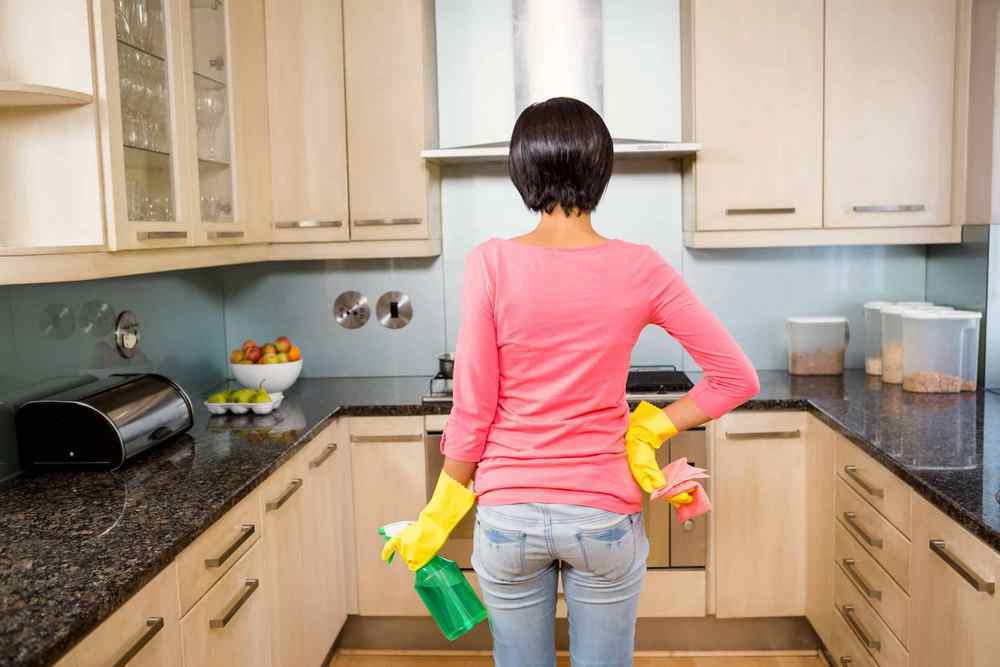Kitchen cabinets often don’t get the same attention as the countertops and floors which get wiped down almost everyday. If not cleaned regularly, kitchen cabinets can accumulate dirt, grease, and cooking residue which only affects the hygiene of the kitchen and introduce bacteria like salmonella on the handles and knobs, but also damages the material of the cabinets! Now, what your cabinets need is simple and regular maintenance at least once a week externally, and at least once a month internally. The idea of having to take out your stuff and clean the cabinets every once in a while might sound burdensome, but it is absolutely necessary and an important health practice!
To make this task easier for you, here are some easy ways you can deep clean your kitchen cabinets:
1. Dishsoap Solution For Scrubbing
Cabinets are all made of different types of materials and simple liquid dish soaps or gentle cleaning solutions work perfectly on metal, laminate, wood and vinyl cabinets. Make sure to not use any abrasive cleaners or scrub brushes because hard scrubbing can damage the materials of the cabinet and peel the paint. You can mix one part mild dishwashing soap and two parts hot water to prepare a gentle cleaning solution that can easily wipe off grease, or any other food buildup from the cabinets. You can also add an insecticide to your cleaning solution to kill all sorts of bugs and cockroaches that may be inside the cabinets.
2. Orange Oil Cleaner For Grease
If the kitchen cabinets have not been cleaned in a long time or it is a busy kitchen with lots of meals being prepared in a day, it is common for grease to form a thick buildup on the cabinet which is really difficult to clean even with a dish soap solution. This problem can be solved by using an orange oil cleaner! Apply the cleaner onto the greasy areas and let it sit for 4-5 minutes before wiping it down. It will surely get all the stubborn grease off your cabinets!
3. Cleaning Glass Features
Classical kitchens with modern design often feature glass door cabinets, which can’t be cleaned with a regular soap solution. You can use a commercial grade glass cleaner by spraying it onto a paper towel or a soft cloth to wipe the glass. A good practice is never spray the cleaner directly onto the glass doors because it can damage the wooden frame of the cabinets and even damage paint.
4. Cleaning the Edges
The mixture you are using to clean the cabinets might not get to the edges and corners that effectively. To make sure that the corners are not left out of the cleaning process, use a toothbrush and baking soda and rub the edges thoroughly! You can also dip the toothbrush in your cleaning solution and use it to rub the edges and other tight spots. Make sure to reach the areas behind the knobs and handles as well for perfectly clean cabinets!
5. Final Cleanse
Don’t leave the cabinets after just wiping them with a cleaning solution. Take a clean cloth and dampen it with water, and wipe the cabinets thoroughly to get rid of any remains of the cleaning solution or grime. Once done with the final cleanse, make sure you dry the damp surfaces with a soft dry cloth instead of letting them air dry because it can damage the paint!
Doing a deep cleanse every once in a while is a great way of cleaning the cabinets, but you can also follow simple steps like dusting them every week, cleaning up spills as soon as they happen etc to keep the kitchen cabinets clean and good to go! It might feel like a hassle to empty the cabinets and clean them with your busy schedule, but it is extremely important not only to preserve the material of the cabinets but to keep your kitchen hygienic, healthy and safe!















